Jack Ramsay of VisionsLive discusses the project with Ilka Kuhagen, Corette Haf, Julia Spink and Susan Abbott
Think Global Qualitative Associates self-funded this multi-country project. We chose the role of dogs in the lives of their owners because we felt this topic presented a great canvas on which to explore global differences. A new online platform (VisionsLive) afforded us an additional opportunity to see how this mobile-enabled technology might, or might not, support a global team of independent qualitative researchers. Participating countries included: Canada, Czech Republic, France, Germany, India, Mexico, South Africa, UK, and USA.  Think Global Qualitative associates (left to right) Susan Abbott, Jay Zaltzman, Ilka Kuhagen, Julia Spink, Rebecca Bryant and Veronique Gaboriau in Budapest, May 2014
Think Global Qualitative associates (left to right) Susan Abbott, Jay Zaltzman, Ilka Kuhagen, Julia Spink, Rebecca Bryant and Veronique Gaboriau in Budapest, May 2014
Our objectives
Objectives that guided the work in each country:
- Understanding the role of dogs in our respective cultures
- Testing a hybrid research methodology, including: Mobile lifestyle documentation, participant video, online discussion, online and mobile ideation (in selected markets)
- Identifying opportunities for category innovation
The target audience
- Primary caretakers of a companion dog
- With computer and smartphone
- Comfortable taking and uploading pictures & video
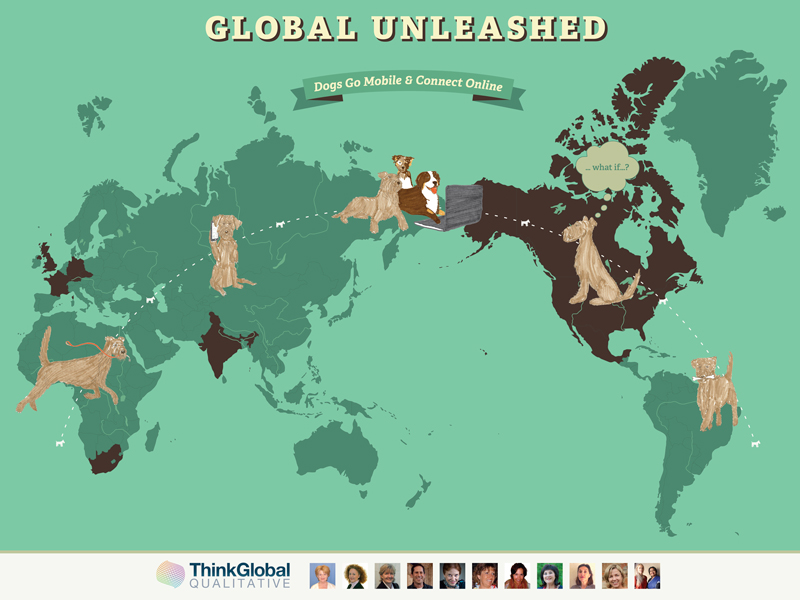
This is the Inspiration Zone Poster presented by Rebecca Bryant to the Worldwide Conference on Qualitative Research in Budapest, May 2014
The logistics of a multi-country immersion for insight
The mobile phone has become, in many ways, an extension of the person. Data shows that mobile phones are usually within 3 meters of the owner. As a constant companion, the handheld device is ideally situated to take us into the lives of consumers.
- There’s an interesting example from our US study of a participant who, unbeknownst to the researchers, agreed to participate in the study during his honeymoon. Only when he “reappeared” after “disappearing” for a few days did we learn he had married during the study period! To him, he was going to have his phone with him – so, he was available!
Increasingly, the internet is accessed with a mobile device, especially in developing economies.(1) Today, that device might be a tablet, not a mobile telephone.This study required all participants to have a smart phone, which did mean a more affluent set of participants in India and South Africa.
We believe that incorporating new communications channels into qualitative insights projects offers our clients unprecedented access to people in their everyday lives. As researchers, we need to know the best ways to incorporate the technology.
We discovered that Google translate along with images helped researchers follow each other’s online discussion forums, even if it was in a language completely unfamiliar to the observing researcher. This enabled the whole project team to stay current with projects as they developed, regardless of the language of the project.
Traditional recruiting methods were used in some countries (Germany, Mexico, UK, Canada, India, Czech Republic). In USA, France, and South Africa, a mix of traditional recruiting, convenience samples and social media recruiting were used.
An inside look at the mobile diary
We started with a mobile diary, and here we see sample screen shots of what it looked like to participants.
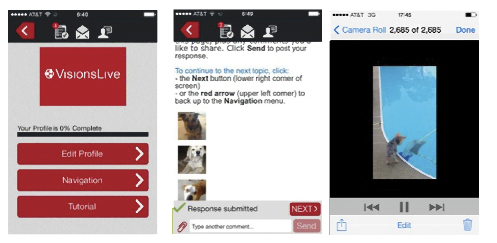 The diaries were private. Researchers could read the entries, but participants could not see each other’s diaries. In their diaries, participants were asked to chronicle each day’s activities as it related to their dog.
The diaries were private. Researchers could read the entries, but participants could not see each other’s diaries. In their diaries, participants were asked to chronicle each day’s activities as it related to their dog.
Fieldwork was not simultaneous. This meant that at each stage of the project, the design could change slightly to accommodate learning. It also was important for each researcher to adjust the tone and approach of the research to their culture and environment.
In the US, a Question of the Day was added to the daily diary exercise to explore how this might encourage participants to go beyond chronicling day-to-day activities.This resulted in robust data in a shorter period of time. Questions of the Day focused on the following:
- Best aspects of having dog
- Dog’s favorite things
- Thoughts/attitudes toward training dog
- Hardest/most difficult part of having dog
- Products/service owner wants but cannot find
Dogs are a source of joy and unconditional positive regard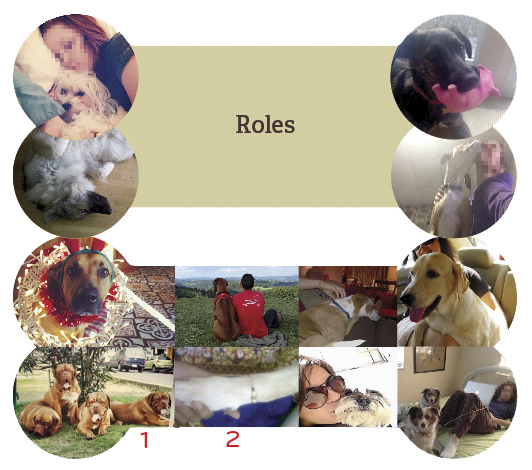
The dog is considered a member of the family, and typically described as such. A consistent theme is the joy and unconditional positive regard that the dog brings to the home and the owner.
I cannot imagine my life without a dog … She’s so sweet and loving … I love that when I … come home, she’s as excited as if I’d been gone for days.(Verbatim from US participant)
In Mexico, the concept of family extended beyond the dog’s human family to the dog’s canine family of origin, as the participant showed us in the photo marked “1” above.
Companionship is an important aspect of having a dog, and this theme emerged in many countries.
Companionship is the major aspect of having a dog … he is a part of our family. I would not trade that for anything. (Verbatim from US participant)
The dog is also a protector. The image marked “2” above shows a dog from India with a Rakhi tied to his foreleg. A Rakhi is a multi-colored thread that a sister ties on the wrist of her brother during an annual holiday. It symbolizes a sister’s love for her brother and the brother’s promise to protect the sister.
He is protective of me like a brother. (Quote from Indian participant)
And, of course dogs are included in holidays.The dog shown with a Christmas wreath and red reindeer antlers was only one example of many we saw of dogs dressed in costumes for the holidays, or just for having family fun.
In additional to emotional insights, we also got unexpected insights.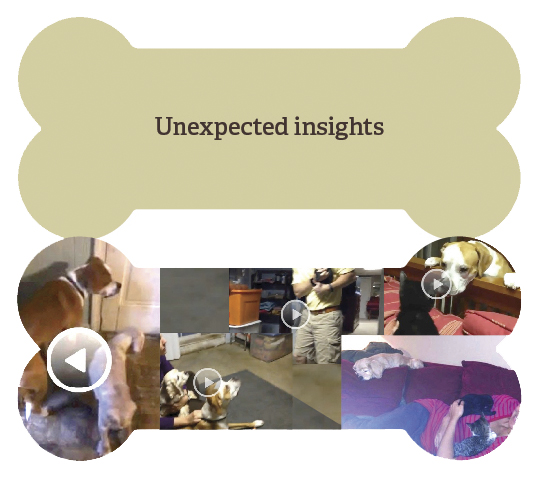
Mobile lets us watch events as they unfold
The series of pictures above are from videos shot over the course of a weekend. It provided the researchers with stage-by-stage documentation of a family introducing new kittens into the home.
It shows the dogs going from suspicious and scared, with the owners being fearful the dogs might hurt the kittens, through the introduction process, to acceptance. At the end we see a still shot of the whole group on the couch: owner and kittens stretched out on the couch with one of the dogs lying on the back of the sofa. The other dog is just off screen lieing beside the couch.
Online discussion forum for multi-stage idea building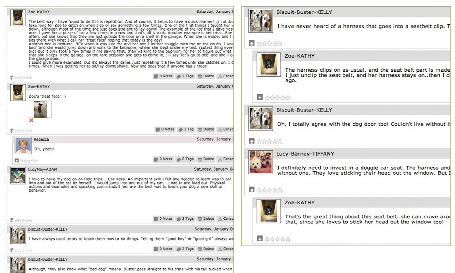
After the diary, participants started a group discussion forum. Here you can see screenshots of what this looked like to the participants. Researchers used the group discussion to:
- Quickly build rapport among participants, and
- As a platform where participants shared and compared their experiences with other dog owners. This included exploring products and services specific to the dog ownership experience
In the US study, we identified 4 potential product/service areas for further exploration. The Four C’s of innovation opportunities for mobile technology that we identified from the diary phase of the project follow.
Communication – participants want better 2-way communication between human and canine
Containment – participants want better ways to contain or track the dog. One example discussed was using GPS on a mobile device for this purpose
Caretaking – the ability to track the dog’s health history / health status / grooming / exercising with technology
Companionship Plus – the ability to interact remotely and/or use a smartphone to create a game for the dog and the human to play together
Owners want to take their dogs everywhere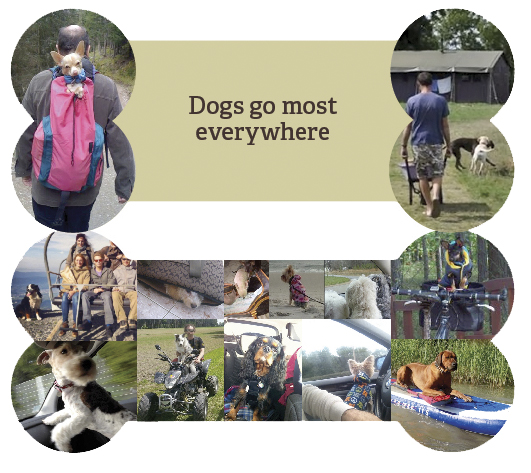
Dogs are a part of most every aspect of their owner’s lives, and go everywhere with them. The photos above show a dog in a bike basket in Czech Republic, on a motorcycle in Germany, in cars in many countries, and in a variety of other outdoor settings. Importantly, each dog is with the family.
In 1953, BF Skinner noted: “dogs excel at interpreting human cues.” This statement has been validated by considerable research since Skinner’s time. Based on this study, it is our contention that those in the pet product and service industries would be well served to watch trends in human products and services as these likely serve as a strong indicator of direction for future products and services for dogs.
Want more information?
A full report was prepared for each country. This brief article provides just a few of the highlights of the research. Please contact any of the associates for more information about the project or the methodologies discussed, or to arrange for a presentation.
(1) Accenture, 2012
